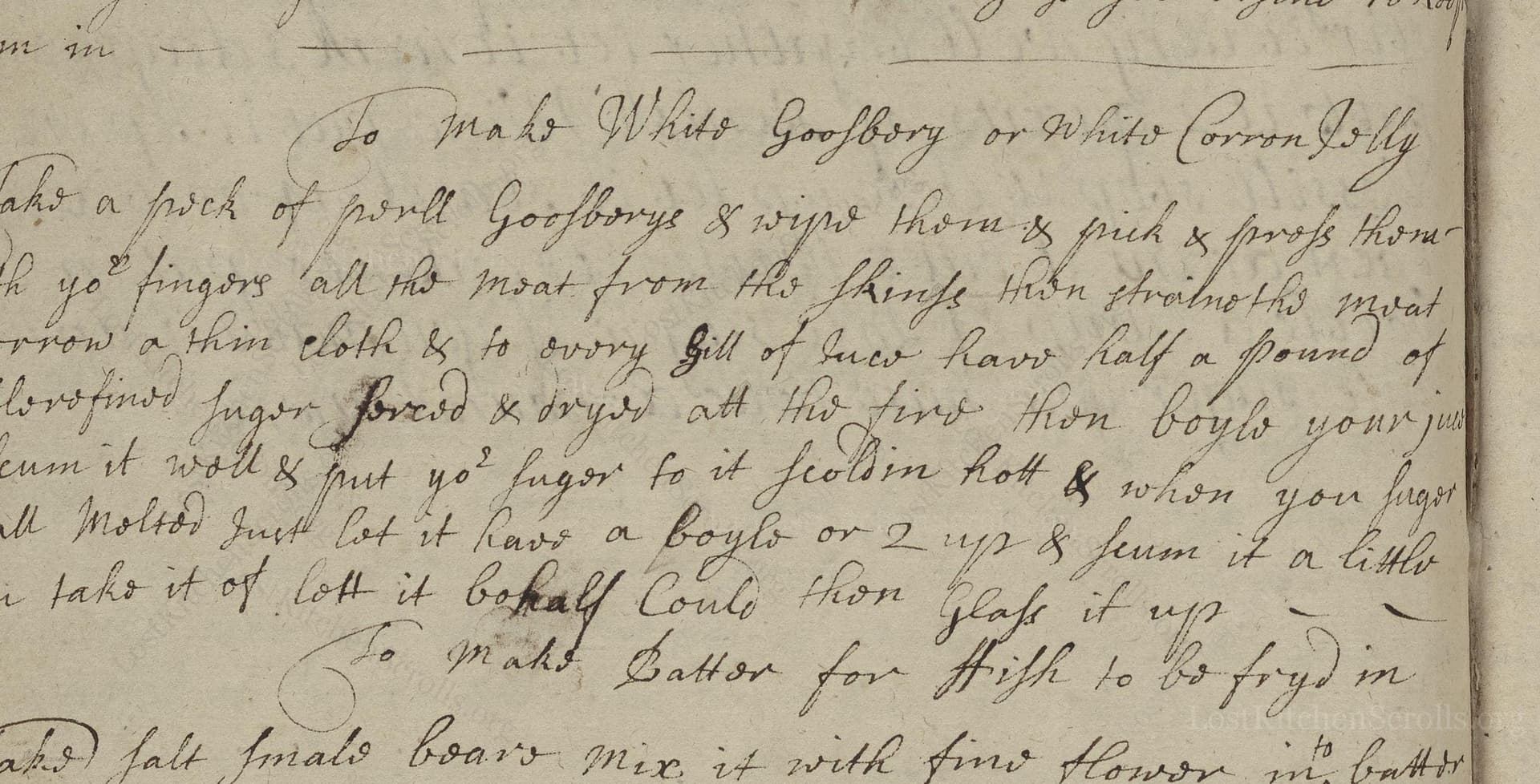To Make White Goosbery Or White Curron Jelly
From the treasured pages of Mrs. Rachel Kirk Book 1707
Written by Rachel Kirk

To Make White Goosbery Or White Curron Jelly
"Take a peck of purell Goosberys & wipe them & pick & press them with yo'r fingers all the meat from the skins then straine the meat thorow a thin cloth & to every Gill of Juse have half a pound of dublorefined suger Poved & dry'd at the fire then boyle your Juse & scum it well & put yo'r suger to it scoldin hott & when your finger is all molted just let it have a boyle or 2 ups & scum it a little then take it of lett it be half could then glass it up --"
Note on the Original Text
The recipe is written in the abbreviated, instructive style typical of early 18th-century manuscripts, assuming familiarity with basic kitchen tasks such as pressing fruit and managing open fires. Spelling is phonetically flexible—'Juse' for juice, 'boyle' for boil, 'scum' for skim—and words blend together. Quantities are given in domestic measures like the peck (about 9 liters) and gill (140ml), while sugar is measured by weight per volume of juice. The text omits many details we expect today, such as the precise cooking times or temperatures, relying on visual and tactile cues such as 'when your finger is all molted.' This reflects a world in which recipes were oral traditions set down in hurried handwriting, meant for readers who already knew their way around a hearth.

Title
Mrs. Rachel Kirk Book 1707 (1707)
You can also click the book image above to peruse the original tome
Writer
Rachel Kirk
Era
1707
Publisher
Unknown
Background
A remarkable collection of early 18th-century recipes, Rachel Kirk's work invites readers into the kitchens of the past where classic culinary traditions and timeless flavors come alive. Expect a charming medley of savory feasts and sweet treats reflective of the era's sophisticated palate.
Kindly made available by
Folger Shakespeare Library
This recipe is drawn from the manuscript cookbook of Rachel Kirk, dating to 1707 in early 18th-century England. Preserving fruits in the form of jellies was a common kitchen practice among middle and upper-class households, both as a sweet treat and a means of extending seasonal abundance. Gooseberries and currants were widely cultivated and valued for their tartness, suitable for creating jewel-like, crystal-clear preserves enjoyed at table or given as gifts.

Historically, cooks would have used a brass or copper preserving pan, a wooden spoon for stirring, and a muslin or fine linen cloth to strain the fruit. The sugar would be dried before the fire on a metal tray or in a gently warmed earthenware dish. Finished jelly would be poured into glass pots or shallow bowls, sometimes covered with parchment or waxed paper. While modern cooks might use stainless steel saucepans and silicone spatulas, the essence of the process remains strikingly similar. Sterilized jars are now standard for storing preserves.
Prep Time
30 mins
Cook Time
20 mins
Servings
20
We've done our best to adapt this historical recipe for modern kitchens, but some details may still need refinement. We warmly welcome feedback from fellow cooks and culinary historians — your insights support the entire community!
Ingredients
- 2 1/2 gallons (approx. 9 lbs) fresh gooseberries or white currants (substitute: red currants if white are unavailable)
- 8 oz (1 cup) caster sugar (superfine sugar) per 1/4 pint juice
Instructions
- Begin by taking about 2 1/2 gallons (a peck) of fresh, underripe gooseberries or white currants.
- Remove stems and tails, then gently squash the berries with your fingers to separate the pulp from the skins.
- Strain the resulting pulp through a clean muslin or fine sieve to extract clear juice.
- For each 1/4 pint (one gill) of juice, measure out 8 oz (1 cup) of double-refined (superfine or caster) sugar.
- Warm the sugar gently in an oven to dry it.
- Bring the strained juice to a boil in a saucepan, skimming off any scum that rises to the surface.
- Add the hot, dry sugar to the boiling juice, stir well, and continue to heat until the mixture just reaches a boil again.
- When the sugar is fully dissolved and the syrup is glossy, skim any foam that appears.
- Remove from heat and allow the jelly to cool until just warm.
- Pour into sterilized jars or glasses while still fluid.
Estimated Calories
150 per serving
Cooking Estimates
It takes about 30 minutes to prepare the berries, including cleaning, stemming, and juicing them. Cooking the juice and dissolving the sugar takes around 20 minutes. Each serving has about 150 calories. This recipe makes about 20 servings.
As noted above, we have made our best effort to translate and adapt this historical recipe for modern kitchens, taking into account ingredients nowadays, cooking techniques, measurements, and so on. However, historical recipes often contain assumptions that require interpretation.
We'd love for anyone to help improve these adaptations. Community contributions are highly welcome. If you have suggestions, corrections, or cooking tips based on your experience with this recipe, please share them below.
Join the Discussion
Rate This Recipe
Dietary Preference
Main Ingredients
Culinary Technique

Den Bockfisch In Einer Fleisch Suppen Zu Kochen
This recipe hails from a German manuscript cookbook compiled in 1696, a time whe...

Die Grieß Nudlen Zumachen
This recipe comes from a rather mysterious manuscript cookbook, penned anonymous...

Ein Boudain
This recipe comes from an anonymous German-language manuscript cookbook from 169...

Ein Gesaltzen Citroni
This recipe, dating from 1696, comes from an extensive anonymous German cookbook...
Browse our complete collection of time-honored recipes



